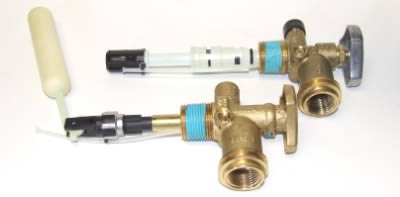OPD Cylinder Valves
 OPD stands for "overfilling prevention device" or "overfill protection device" and is required on all 4 to 40 pound DOT cylinders in vapor service. The OPD valve is simply a protective device that, as the name implies, prevents overfilling of a propane cylinder. Before any propane cylinder (4 to 40#) can be filled with propane, the cylinder will be inspected to ensure that an OPD valve is installed on the tank. Propane companies can generally replace the non-compliant cylinder service valve with the required OPD valve quickly in order to bring it into compliance. Many consumers believe that the OPD valve was introduced to increase the profitability of propane dealers regarding cylinder filling. This statement could not be farther from the truth. When filling a propane bottle equipped with an OPD valve, the flow of gas stops immediately when the overfill protection mechanism closes. This is extremely hard on a propane dispensing pump resulting in more repairs and pump overhauls which can be quite expensive. The propane industry spends more money than they save as a result of the OPD valve requirement.
OPD stands for "overfilling prevention device" or "overfill protection device" and is required on all 4 to 40 pound DOT cylinders in vapor service. The OPD valve is simply a protective device that, as the name implies, prevents overfilling of a propane cylinder. Before any propane cylinder (4 to 40#) can be filled with propane, the cylinder will be inspected to ensure that an OPD valve is installed on the tank. Propane companies can generally replace the non-compliant cylinder service valve with the required OPD valve quickly in order to bring it into compliance. Many consumers believe that the OPD valve was introduced to increase the profitability of propane dealers regarding cylinder filling. This statement could not be farther from the truth. When filling a propane bottle equipped with an OPD valve, the flow of gas stops immediately when the overfill protection mechanism closes. This is extremely hard on a propane dispensing pump resulting in more repairs and pump overhauls which can be quite expensive. The propane industry spends more money than they save as a result of the OPD valve requirement.
OPD Valve Information
Propane bottles equipped with overfill prevention valves are recognizable by the triangular hand wheel at the top of the valve itself. The hand wheel connecting to the valve stem is tamperproof and is not interchangeable with a cylinder not equipped with the overfill prevention safety mechanism. The OPD valve was not designed as a tool to let the bottle filler know when the bottle has reached its capacity. It was designed as a secondary safety mechanism. Bottles equipped with OPD valves are still to be filled by weight as required by law.
OPD Valve Operation
Propane OPD valves operate inside the bottle and are activated as the liquid propane in the cylinder rises to a level that pushes a float upward stopping the flow of gas into the bottle. This action is similar to that of a float valve in a toilet; once the water in the bowl rises to a certain level, the flow of water stops. The OPD valve is only actuated during the filling process, not during operation. In other words, inverting a cylinder will cause an OPD float to actuate but it will not stop the flow of gas out of the cylinder. Why is this important to know? Because the OPD valve is not designed to restrict flow out of the cylinder, it's only designed to stop flow into the cylinder during the filling process. OPD equipped propane cylinders will allow liquid propane into gas lines and hoses if tipped over or inverted. Overfill Prevention Devices are not a safety mechanism used or actuated during cylinder usage.
OPD valves are also designed to only allow propane into and out of the bottle if attached to the appropriate hose end connection. The threads on this type of connection are called ACME threads and are visible on the OPD valve at the point of connection. The ACME threads are easily identified by how much larger and farther apart they are as compared to normal pipe threads. OPD valves will not allow propane out of the bottle if it is not hooked up to anything. This is why turning (opening) an OPD handwheel on an unattached bottle does nothing in terms of letting propane out. Many people think that the bottle is empty but in fact, the cylinder needs to be hooked up to allow any gas out. Learn more about the Valve Open - No Propane issue that many users have with OPD equipped propane cylinders.
